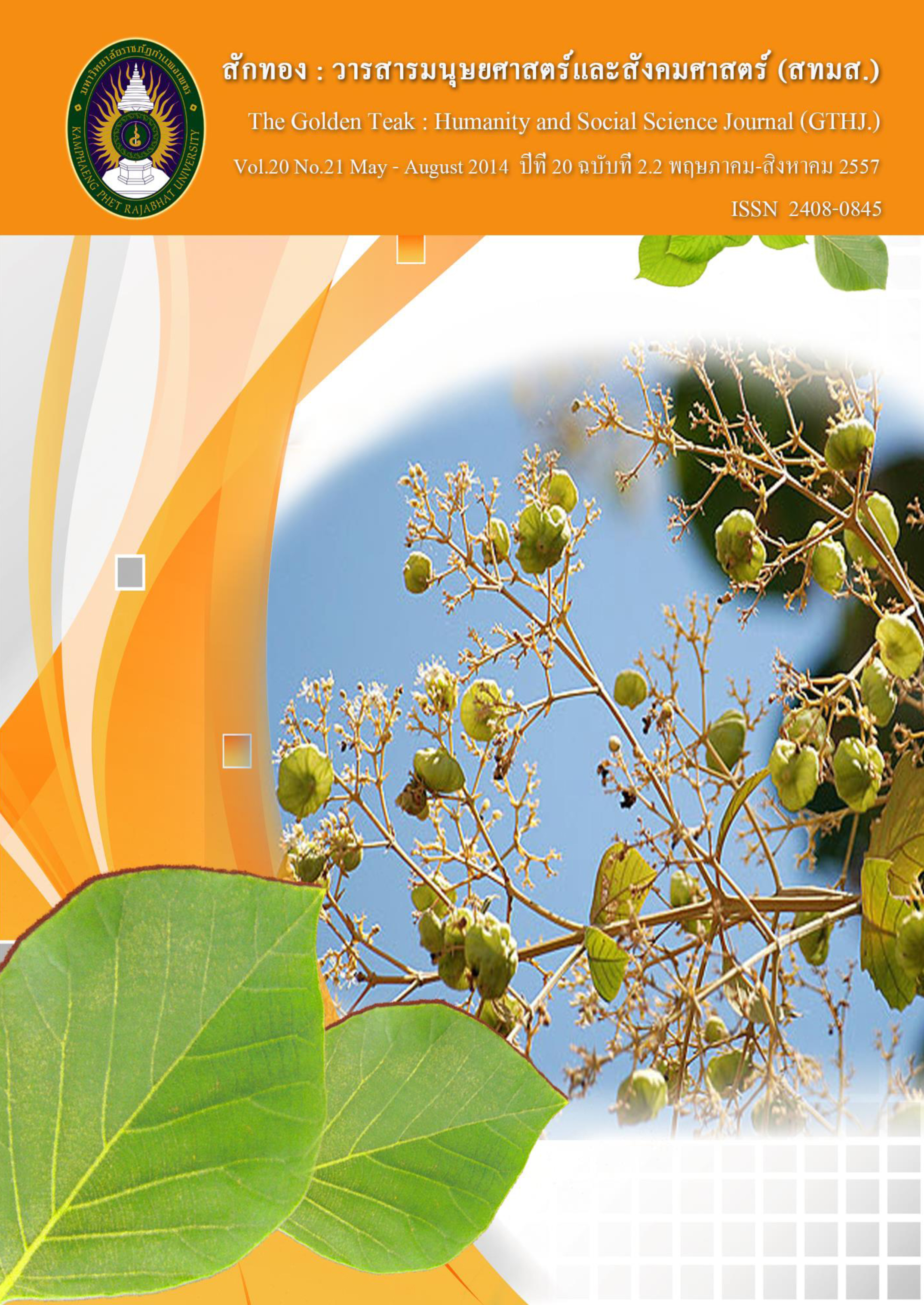Model of Quality System Management of World Class Standard Schools under the Office of Basic Education Commission
Main Article Content
Abstract
The purposes of this study were: 1) to study the present condition and problems in quality management system world class Standard Schools under the Office of Basic Education Commission, 2) to study the components of quality management system world class Standard Schools, 3) to develop the model of quality management system world class Standard Schools, and 4) to examine the model of quality management system of world class Standard Schools. The sample in this study included: 1) 4 administrators of outstanding world class Standard Schools under the Office of Basic Education Commission, 2) 15 experts consisting of university instructors teaching educational administration and administrators in world class Standard Schools under the Office of Basic Education Commission. The research instrument included: documents, an interview, and a questionnaire asking the utility, possibility, suitability, and correctness of the model. The quantitative statistics used to analyze the data were frequency, percentage, mean, and standard deviation. The qualitative analysis was content analysis. The findings were as follows: 1. The present condition and problems of the model of quality management system of world class Standard Schools under the Office of Basic Education Commission revealed that there were: teaching and learning activities, internal assurance, use of instructional technology, research for educational development, and measurement of learning performances such as O-NET, N-T of the students in the previous year. The results of comparison between the performance of schools in the previous year and the model of quality management system of world class Standard Schools under the office of Basic Education Commission were as follows: As for academic administration, it was found that teachers lacked knowledge of integrating contents, skills, and knowledge in teaching according to instructional strategies, skills in curriculum analysis which led to not being able to apply leaning activities in accordance with the curriculum, knowledge in using instructional media, and knowledge in managing student-centered activities. As for personnel administration, it was found that teachers were not qualified, teachers were not specialized in their field of study, and teachers lacked experiences, aptitudes in teaching performance and lacked responsibility in their work. Also they had debt problems, problems in knowledge in the subjects and skills concerning curriculum, lesson plan, research and development. They also had other tasks besides teaching such as financial work, paper work about materials and community relationship. As for problems in budget, there was not enough budgeting for management and a delay in budget payment. As for general administration, teachers were not keen in using technology for paper work due to promotion exams; there were problems in international education network and problems in using English for communication. 2. In terms of components of quality management system of standardized schools under the Office of Basic Education Commission, there were 9 components as follows: organizational leadership, strategic planning, emphasis of students and related personnel, analysis and knowledge management measurement, systematic process, personnel emphasis, educational administration process, quality control of the organization and emphasis on performance achievement according to the standard fixed 3. In terms of the model of quality management system of world class Standard Schools under the office of Basic Education Commission, there were 4 parts as follows: 1.1) organizational leadership consisting of principles, objectives, and context; 1.2) quality management system of world class Standard Schools under the office of Basic Education Commission, consisting of 3 dimensions: dimension 1 – method of quality management system “AGTIC” consisting of analysis, goal setting, teamwork, implementation and control, dimension 2- components of quality management system consisting of components, dimension 3- authority consisting of 4 task: academic management, personal management , budgeting management and general management. 1.3) the use of the model consisting of 4 parts: preparation, usage, measurement of performance and conclusion of performance; 1.4) condition consisting of condition of success and condition of failure. 4. In terms of examination of quality management system model of world class standard schools, it was found that as a whole and each component of the model were at the highest levels. The usefulness, possibility, suitability, and correctness of all aspects were also at the highest level.
Article Details
บทความที่ได้รับการตีพิมพ์เป็นลิขสิทธิ์ของวารสาร สักทอง : วารสารมนุษยศาสตร์และสังคมศาสตร์ สถาบันวิจัยและพัฒนา มหาวิทยาลับราชภัฏกำแพงเพชร
ข้อคิดเห็นใดๆ ที่ปรากฎในวารสารเป็นวรรณกรรมของผู้เขียนโดยเฉพาะ ซึ่งมหาวิทยาลัยราชภัฏกำแพงเพชรและบรรณาธิการไม่จำเป็นต้องเห็นด้วย
References
ดิเรก วรรณเศียร. (2551). การวิจัยและพัฒนารูปแบบการจัดการศึกษาโรงเรียนมาตรฐานสากล. สำนักบริหารงานการมัธยมศึกษาตอนปลาย. กรุงเทพฯ: สำนักงานคณะกรรมการการศึกษาขั้นพื้นฐาน.
วิชัย ตันศิริ. (2547). ขับเคลื่อนการพัฒนายกระดับโรงเรียนชั้นนำที่มีความพร้อมสู่โรงเรียนดีมีมาตรฐานสากล. การศึกษาดุษฎีบัณฑิต สาขาวิชาการบริหารและพัฒนาการศึกษา มหาวิทยาลัยมหาสารคาม.
วรณัน ขุนศรี. (2549). การจัดการเรียนเพื่อพัฒนาทักษะในการคิด ในกลุ่มสาระการเรียนรู้คณิตศาสตร์, วิชาการ.
พิณสุดา สิริธรังศรี. (2549). การนำเสนอรูปแบบการจัดการศึกษาของสำนักงานเขตพื้นที่การศึกษา. กรุงเทพฯ: จุฬาลงกรณ์มหาวิทยาลัย.
พรเพ็ญ ทัศนเมธิน. (2544). ทัศนะของผู้บริหารห้องสมุดสถาบันอุดมศึกษาของรัฐต่อการเปลี่ยน แปลงองค์การ. กรุงเทพฯ : จุฬาลงกรณ์มหาวิทยาลัย.
ไพชยนต์ จันทเขต และคณะ. (2553). การวิจัยและพัฒนารูปแบบการจัดการศึกษาโรงเรียนมาตรฐานสากลของโรงเรียนประสาทวิทยาคาร. จังหวัดสุรินทร์.
ศึกษาธิการ, กระทรวง. (2546). พระราชบัญญัติการศึกษาแก้ไขเพิ่มเติม (ฉบับที่ 2) พ.ศ. 2545 พร้อมกฎกระทรวงที่เกี่ยวข้องและพระราชบัญญัติการศึกษาภาคบังคับ พ.ศ. 2545.กรุงเทพฯ: โรงพิมพ์องค์การรับส่งสินค้าและพัสดุครุภัณฑ์ (ร.ส.พ.).
สุมาลี ขุนจันดี. (2541). องค์ความรู้ของแนวคิดการเสริมสร้างพลังในองค์กร. กรุงเทพฯ : ฐานข้อมูลวิทยานิพนธ์ไทย.
สำนักงานคณะกรรมการการศึกษาขั้นพื้นฐาน. (2554). แผนยุทธศาสตร์สำนักงานคณะกรรมการการศึกษาขั้นพื้นฐาน ปี พ.ศ. 2554. กรุงเทพฯ : โรงพิมพ์ชุมนุมสหกรณ์การเกษตรแห่งประเทศไทย.
อนันต์ เตียวต๋อย. (2553). รูปแบบการบริหารคุณภาพแบบเบ็ดเสร็จในมหาวิทยาลัยเทคโนโลยี ราชมงคล. ปทุมธานี : มหาวิทยาลัยเทคโนโลยีราชมงคล.
Krejcie, R. V. & Morgan. (1970). Educational and Psychological Measurement. New York : McGraw-Hill


